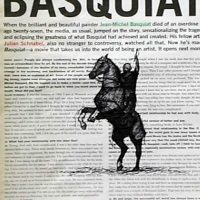My studio practice is interdisciplinary, I am using new mediums (video, digital technology) as well as traditional techniques, such as drawing, painting and I also make my works with the use of found objects, images and texts. In the past few years I showed a number of performances, I set on a live horse and “guarded” the exhibitions. Most recently I am creating environments for my works, where next to large oil paintings I show video projections. Often smaller collections will be shown within the same space, like for example painted over magazine adverts or interviews. I am interested in the artist’s body in the landscape and that how is possible to perform this body through experience. Experience is really experience, something that really happens, something to make work about, only when we are pushed to the limit of the possible, to the edge of the impossible, driven to an extreme, which focuses us to be at our best. The experience of the impossible is the very quality that defines religion and there is a fundamentally religious quality to human experience itself. There is a deeply religious element within us all, with or without religion. After the modernist idea, that science is exclusively the truth, we learned from postmodernity that religious truth is also true, although it is a different kind of truth to the scientific truth. There is something deeply true about religion, but it is a truth without knowledge, without absolute or capitalized knowledge. Any given faith is a way to see and to know, since all knowledge depends on faith, and all faith is a way of seeing, constructing, knowing. Religion is a human practice and it belongs to an order, that Augustine called “facere veritatem”, “making” or “doing” the truth, especially if we are asked to do the impossible. I was interested in that humans are species, which are sitting on another animal’s (horse) back and that this is suggested by the animal to man to do so. It is a deed, not a thought that demands our response, that costs us our blood and tears especially if we do not know who we are. I put myself in question with a question, that is addressed to me- What do I love, when I love horsearchery? So what has dropped from the sky to me is not an answer, but a question. All I am left with is the passion and the not knowing. I am interested in this kind of postmodern augustinian way to confess, that we do not know who we are and that is who we are.
In the Herman Gallery HA relates the exhibition as a whole (also) to a kind of breading out. The portrait drawings are made onto found magazine pages. Pages of art magazines, fashion magazines and daily newspapers, where text and image in some ways is connected to the horse portraits. The drawings are giving new meaning to the medium of newspaper/magazine and its subjects and at the same time they are experimenting with the interpretation of horsearchery in a contemporary cultural context. This way the simple pen drawings are playing with text and image, time and space.
Beata Veszely
